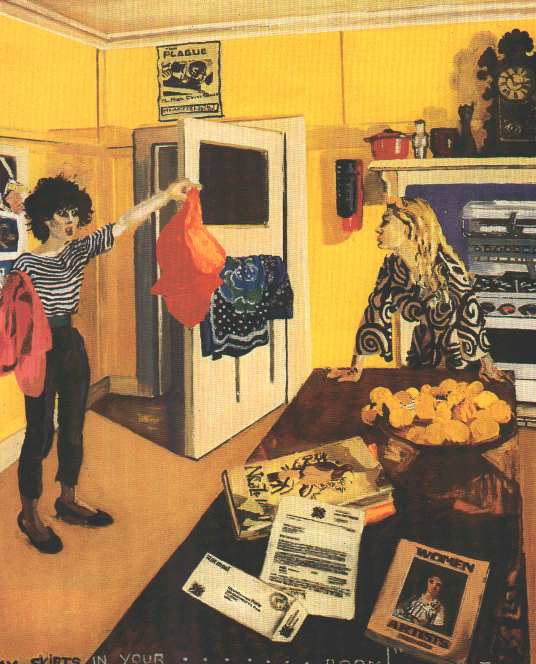The Women's Art Movement and Feminist Art
Discuss how feminist concerns have been expressed through choice of subject, materials and art-making methods in at least three works produced since 1970 by New Zealand women artists.
Until the late 1960s the idea of the artist was unquestionably masculine. The Women's Art Movement was closely aligned with the Women's Movement, which arose in the 1970s. It sought artistic equality in terms of education, exhibitions, criticism and recognition and criticized all aspects of the continuing oppression of women in the visual arts.

Jacqueline Fahey, My Skirt's in your ....... Room! 1978--79
Jacqueline Fahey was one of the first New Zealand women artists to paint from a feminist perspective. She used her domestic surroundings as a source for her art which dealt with her feminist analyze of society. My Skirt's in Your ¡K¡K. Room! (1978) deals with an argument between Fahey's teenage daughters over clothes. The argument takes place in Fahey's kitchen, the detail of which is included in a realist style. The setting and subject can be seen as a desire to validate the domestic and personal. The painting also makes a strong political statement. Fahey saw a lack of awareness of the conditions under which women artists work when the QEII asked her to complete two new paintings by Christmas -the letter is included in the foreground. On the table also, is a copy of Ann Sutherland Harris and Linda Nochlin's Women Artists 1550-1950, a crucial text that rediscovers and reevaluates historical women artists.
Vivian Lynn's The Gates of the Goddess (1986) redirects attention to those ages and cultures in which the female principle was divine and powerful, it is used to challenge the patriarchy. The Gates of the Goddess consisted of three panels. The left-hand-side panel has a grid of 40 bags. These containers represent the number of years between the beginning and end of menstruation. The right-hand-side panel's surface is peeling off as a metaphor for 21st century woman, as they peel away the traditional, out-mode roles. On the gridded centre panel is a generic female figure. The use of the material as part of the political construction of meaning. The torn, damaged tapu cloth was collected by the artist, then cleaned and put together as a re-vindication of women's work. The use of imagery from different cultures and times offering alternatives for the way women sees themselves. The usage of tapa cloth is of interest as it is a material made by women and hence involves a collective approach to art making, thus challenging the patriarchy. It also challenges the fact that tapu is disregarded and seen as secondary.
Carole Shepard's John (1981) is a modular piece made up of individually boxed images. It is multi-faceted and shows photographic images of the subject's face, various parts of his body and shows the subject in different roles - father, musician and lover. In this work Shepard begins to develop an alternative convention to the stubborn tradition of the erotic female nude. By depicting the erotic male nude, Shepard deals with the issue of the female gaze, creating work that a female audience can view comfortably.
Back to Top
Back to Modern New Zealand Art
Back to Home

